La pesca a mosca valsesiana
(including videos below)
Valsesian fly fishing (in Italian “la pesca a mosca valsesiana”) is a proud tradition from the Piedmont region, Northwestern Italy. Its “code of practice” is cared for by a small number of passionate anglers. Fly fishers around the globe owe a large debt to their dedication...
In the most basic terms, it involves teams of wet flies, cast on horse-hair lines and long rods. Traditionally the butt and middle part of the rod was made from river-cane “Arundo donax” – with a more flexible material for the tip (originally hazel, or sometimes a softer cane).
This article shares "how to" information as well as the importance of the spirit of valsesiana...
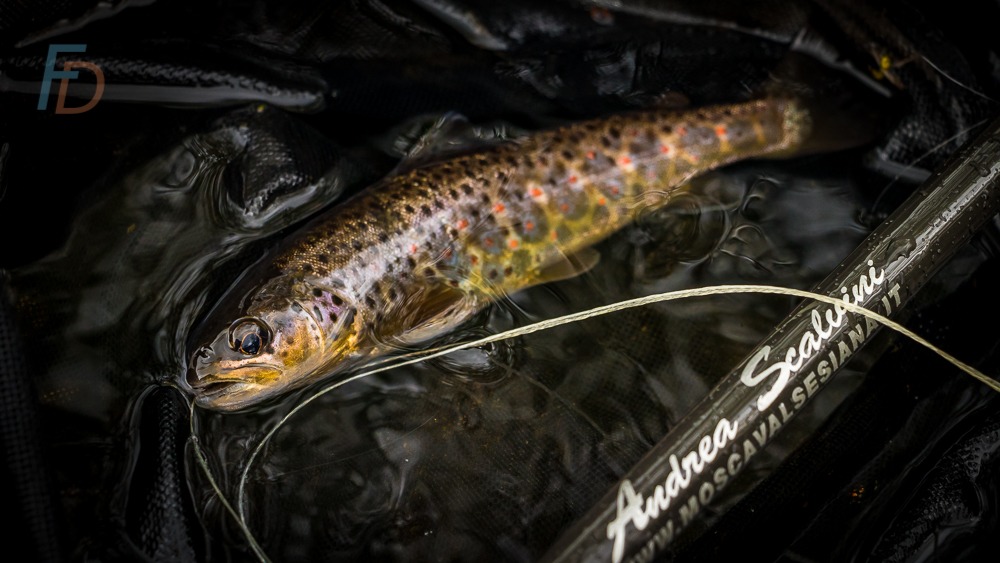
English trout caught on Valsesiana rod and horsehair line - both made by Andrea Scalvini
The fact this wet fly fishing style is still practiced today is a window into a living history filled with lessons on how to improve your knowledge and techniques of presenting a fly. For “valsesiana” the details are very important (but that is always true in fishing).
Because the details are important, it is essential to be as accurate as possible when representing the spirit and methods of Valsesia. Practitioners are concerned that mistakes and myths could easily be created by people from outside the region. We have certainly seen this with Japanese tenkara!
Protecting “Valsesiana”
A primary guardian of the traditions from the current generation of anglers is Andrea Scalvini. In his words
I know that sooner or later someone will try to distort this technique, as has happened with many others in the past.
Andrea’s approach is to record and pass on what is known by the current elders of valsesiana traditions. Two very important figures are Arturo Pugno and Renato Gonetto (as we will see). I would urge anyone reading this article to please also visit Andrea’s site to benefit from his insights.
But first - an important fact...
I am learning (not teaching) pesca a mosca valsesiana
From what I've said already, you can see why it is important for me to be truly careful in what I report here. That’s why I’ve made sure to show flies that Andrea kindly provided (tied directly to traditional horsehair tippet) – as well as his authentic horsehair casting lines and one of his signature (modern) rods.
In any videos showing me trying out the methods for myself – this is me documenting the process as I learn (so that you can come along on that journey).
It is not a representation of “the finished article” – I have a long way to go yet.
By sharing my own progression I will, inevitably, update my own reference points as I learn more.
I believe we all need to take the same approach as Andrea and take our cues from the source - whatever branch of angling we explore. Here is an early fish capture on my journey to learn more.
The Valsesiana Fly (Mosca)
Great importance is placed on the hackle in this style of fishing from the Sesia Valley (a literal translation of “Val de Sesia”). Hackles from domesticated/farmed birds are not used. Instead they come from wild species – either as a by-product of hunting or even found after a wild predator has made a kill.
Be aware, feathers used in the valsesia tradition may not be legal or appropriate to source in your own fly tying today.
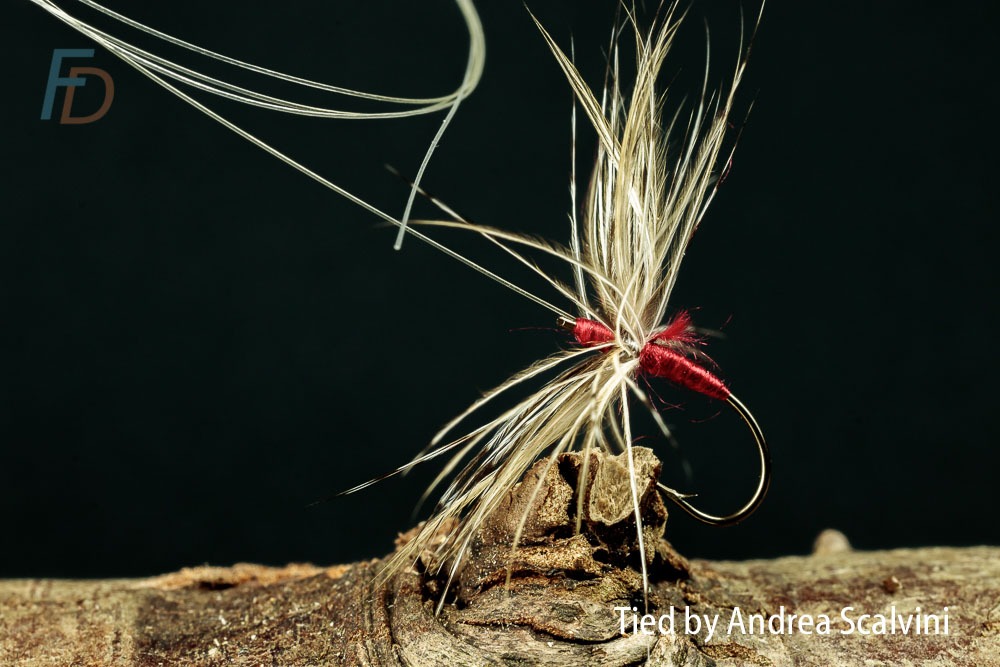
Tawny Owl and red silk
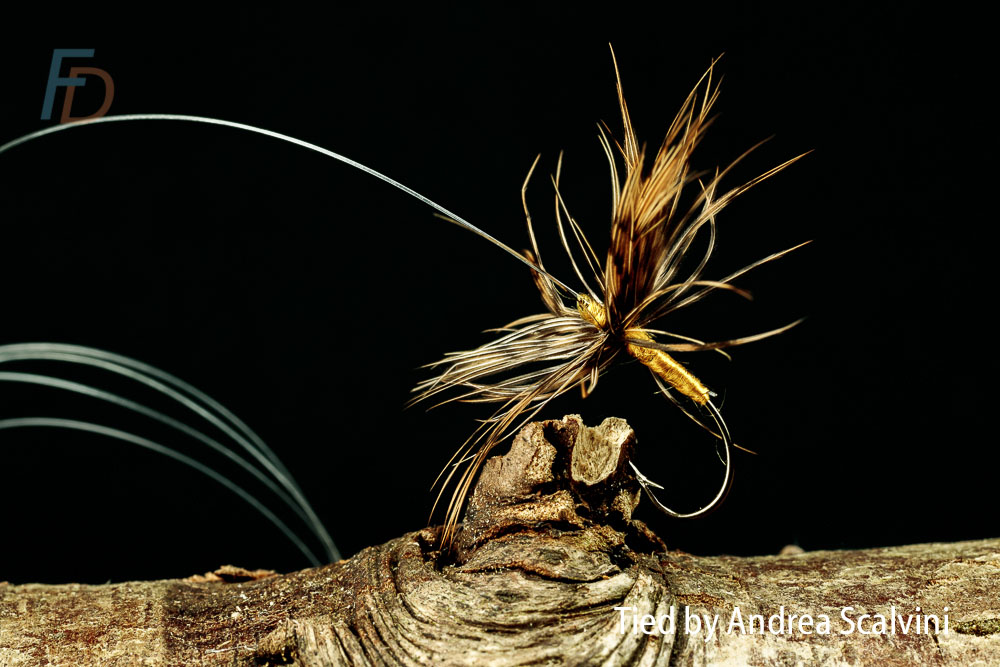
Woodcock and orange silk
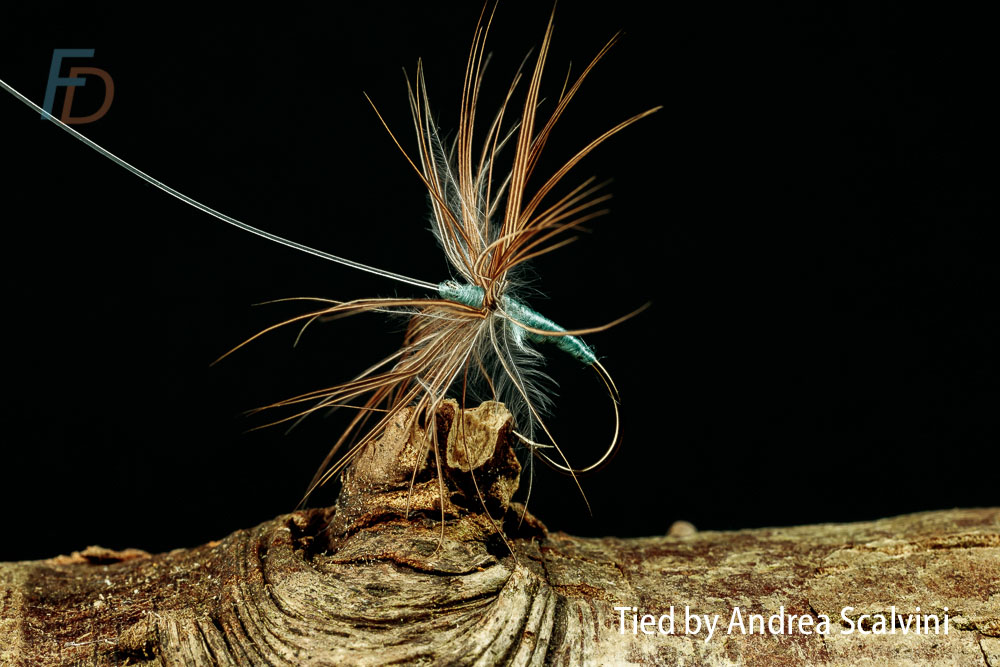
Rock Partridge and pale blue silk
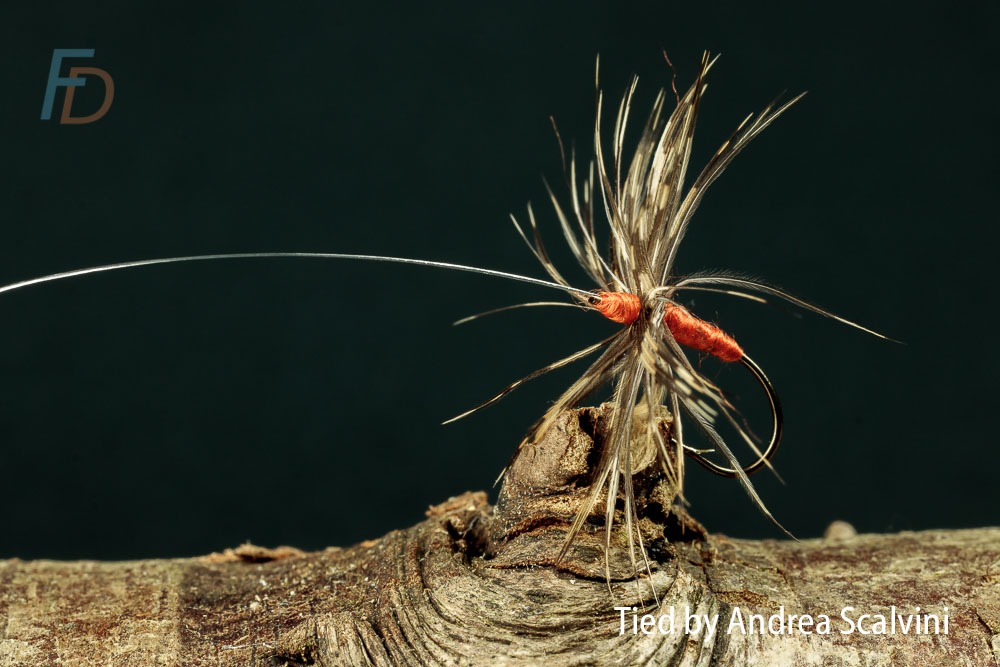
Black Grouse and dark orange silk

Rock Partridge and green silk
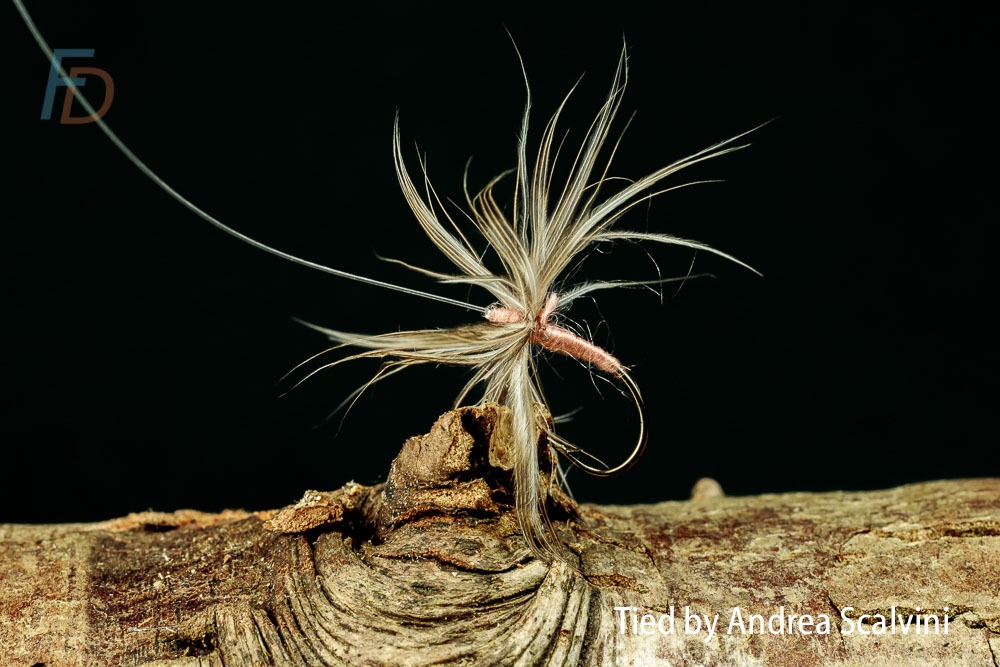
Tawny Owl and pale rose silk

Hen Pheasant and pale grey/blue silk
A wide variety of hackles are used from many different species of bird. Part of becoming a good fly fisher is to have a strong understanding of fly tying materials – and exactly how they function. In pesca a mosca valsesiana, understanding feather properties is very important.
Using a soft feather (piuma morbida) helps a fly to sink deeper – as well as having plenty of natural mobility.
Hackle barbs from stiffer feathers (piume più rigide) help to keep a fly at, or closer to, the surface when cast into the rapid flows of mountain rivers. Stiffer feathers also shed water more easily when false-cast.
Three commonly-used species (though there are very many more!) are:
Of course, the properties of feathers don’t only vary by species – it also depends on where each feather comes from on the bird. You can listen to Arturo Pugno explaining more about this in the video (produced by Patagonia) at the end of this article.
As you can see from the photographs, I am fortunate to have a sample of Andrea’s flies that are tied in the traditional manner – directly to a single strand of horsehair tippet. Notice the variety of different feather types and how they vary in character. For instance how much softer and more “webby” some of the hackles are compared to others with stiffer barbs.
High Rod Tips Work for all River Fly Fishing
I'll get into the Italian silks used in these flies next - but before that you might like to take advantage of my Free short-cut tactics for success in fly fishing on flowing water. Just like the video above (and the high rod tip position allowing line to be held off the water), there are many common elements to successful approaches to river fly fishing.
Just Click Here or on the Book Image/Button below to register for your Free Copy - plus 5 more fishing secrets via email:
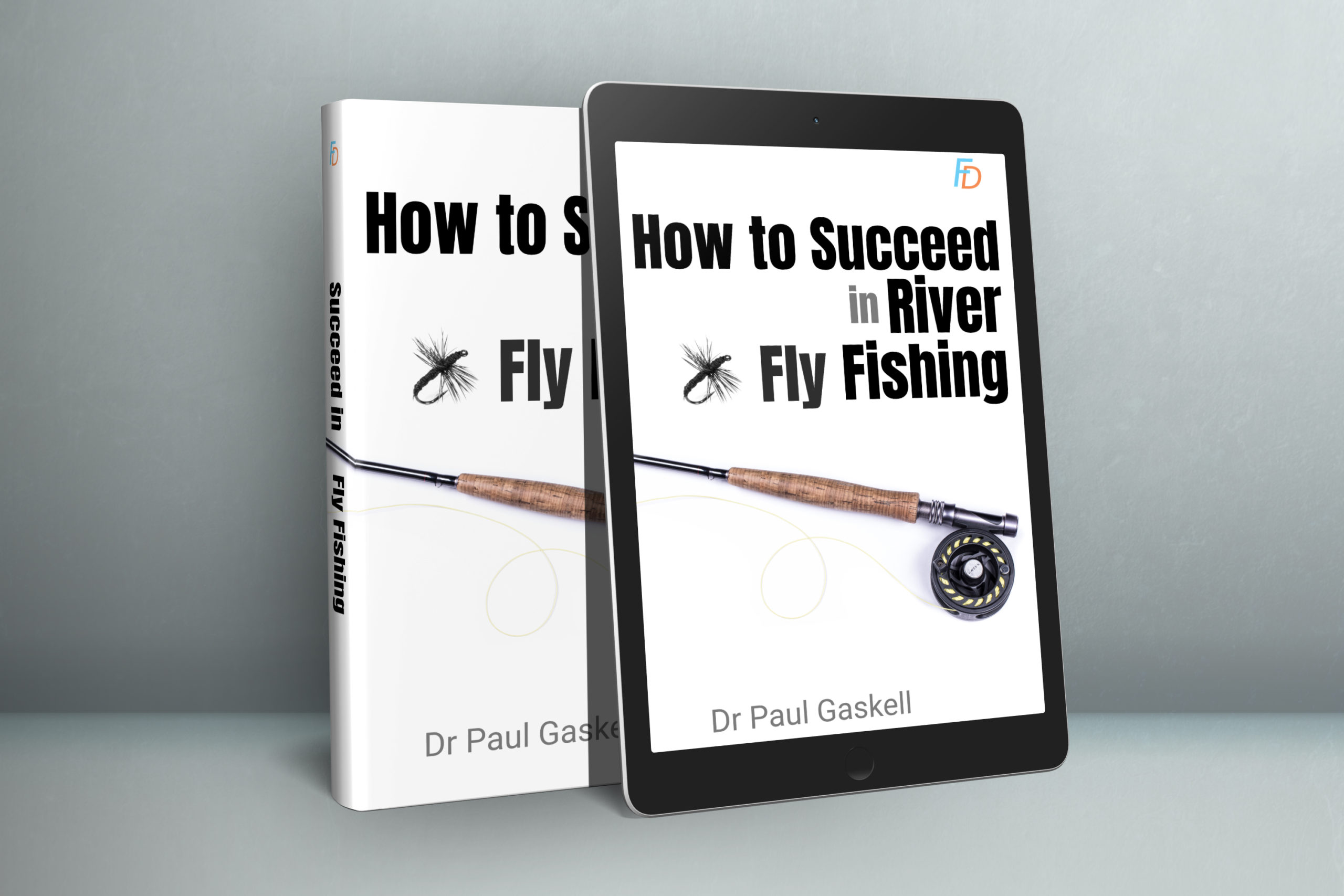
Italian Silk
The bodies of “mosche valsesiane” (valsesian flies) are usually made from a single ply taken from a 3-ply silk yarn. There used to be a famous silk manufacturer in Varallo, where Andrea Scalvini was born. This style of Italian silk (“seta”) is preferred because it gives a very pleasing effect when wet – and it is available in so many different shades.

Bozzolo Reale Italian silk with valsesiana wallet and flies
The silk that I bought to learn to tie in the valsesiana style is of the brand Bozzolo Reale, and is one used by valsesia anglers today.
Similarities to English North Country Soft-hackle Wet Flies
The style of silk, hackle and dressing directly to tippet looks so much like the English North Country Spider tradition. My suspicion is that styles similar-to (and including) valsesiana fly fishing are older than the English tradition (judging by frescos that pre-date any records in the UK). Maybe the ancestral style travelled to England with Christian monks?
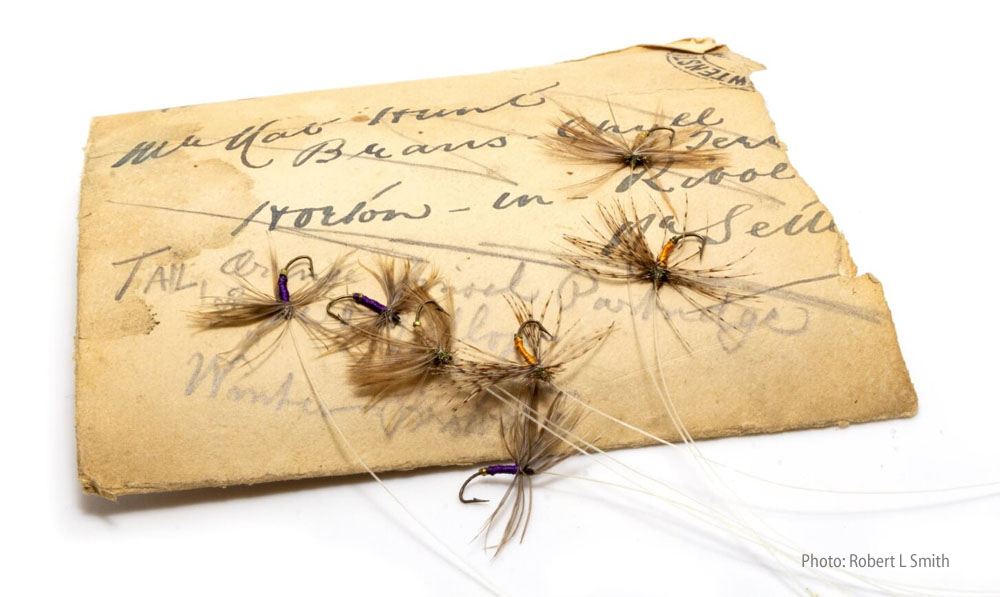
The photo above is from Robert Smith's collection (author of "The North Country Fly"). It shows North Country Spiders dressed directly to horsehair tippet by Nat Hunt. You can discover more about the English North Country fly tradition on Rob's Sliding Stream Blog.
Valsesiana flies are tied in the hand
I am very fortunate to have met, through fly fishing, Emanuele Gonetto - the son of Renato Gonetto. Manu, as he is known, is an exceptionally skilled fly fisher who teaches the Italian style of modern fly casting under the technical direction of Massimo Magliocco.
Last year Manu very kindly brought back some of his personal footage (taken on his phone) that he knew I’d be interested in. The clip features the master Arturo Pugno tying one of his flies in the hand after a meal with friends. You get to be a fly on the wall when you watch Manu’s video below:
Teams of Flies: How to link your "moschetta"
Although numbers might vary through history, it is common to use a team of three flies on a cast for pesca a mosca valsesiana. The creation of droppers uses the same method today (with modern tippet material) as the technique originally used with horsehair. Here’s how to do it:
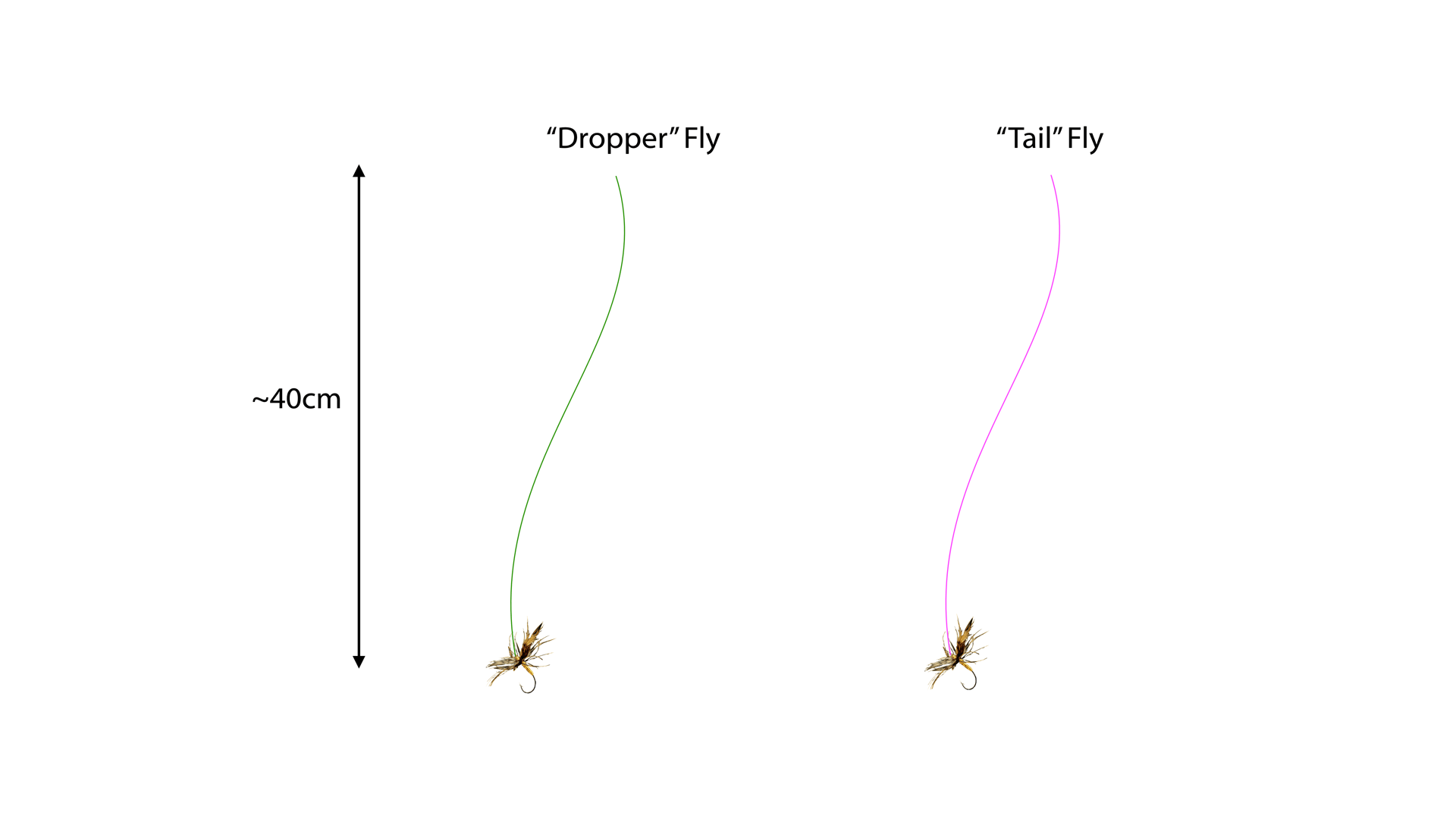
Step 1: Start with your flies already tied to approximately 40 to 50 cm of tippet

Step 2: Set the length of your dropper to around 5cm by forming a loop with the tag-end to the rear of the main leg

Step 3: Now lay the butt-end of the tail-fly tippet in front of the loop and pass the fly around both legs twice

Step 4: NOW PUT THE TAIL FLY TO THE LEFT (and the dropper section to the right). Make the same knot in the tag end by forming a loop and making two turns through it with the tag end. Wet and cinch both the fly dropper knot and the tag end knot down.
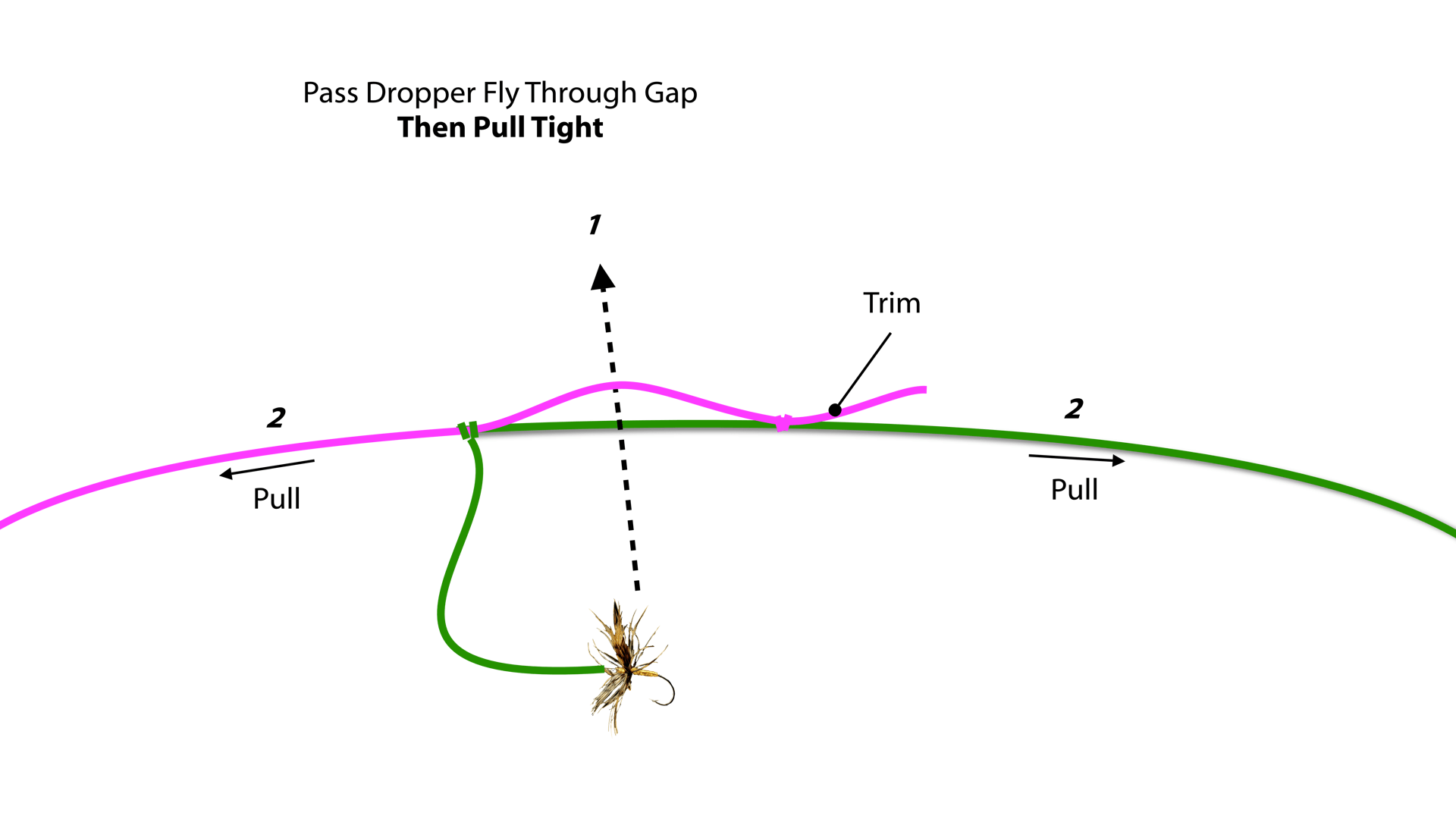
Step 5: Trim the waste tag and then thread the fly between the overlapping sections of tippet. Then pull on both pieces of the main tippet to slide the two knots together. Make sure to pull the dropper tight as the sliding knots cinch down - this is what makes the dropper stand out at 90-degrees to the leader.
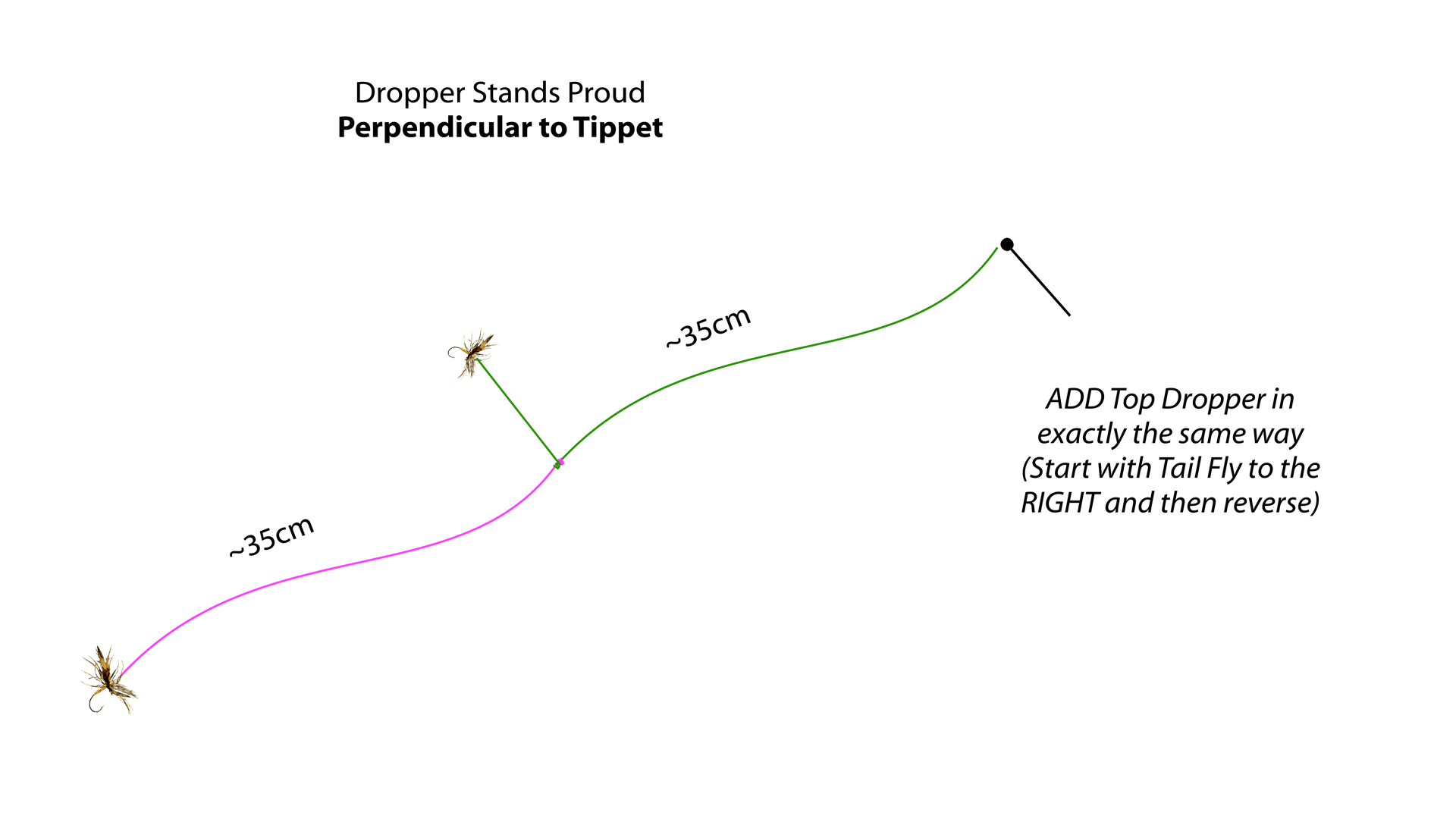
Step 6: With everything cinched down, you can now add a top dropper using the same process
Take care to note the REVERSAL of the tail and dropper strands at Step 4. This makes it easier by first setting the dropper length before completing the other half of the knot.
After knotting the team of dropper and tail flies together, in parts of Italy outside of Val de Sesia, teams of flies can be known as “trenino” – which translates into English as “little train”...This is a great mental image of a little locomotive with its carriages in tow.
HOWEVER, anglers growing up and living within the true valsesiana culture do not use this term. Instead, their teams of flies are simply "moschetta".
Notice the relatively short spacing between flies. Somewhere around 35-cm (14 inches) is normal.
Compared to the standard mantra of “three feet apart” for many modern wet fly fishers, this creates quite a compact team of flies.
Valsesiana anglers often develop a favourite team of three flies that almost always make up their cast. Also, after a particularly memorable fishing trip, you might save the actual "moschetta" responsible for your red-letter day. These can be kept inside a pocket of your fishing wallet.
This is a great point to introduce another typical piece of equipment in valsesia…
Your Fishing Wallet (portafoglio) for Valsesiana
The Valsesian anglers' wallets – or portafogli - are magical items. As well as your pre-tied “moschetta” casts/droppers, they carry lengths of silk, feathers, hooks, scissors (all to allow fly-making on stream when required), casting line(s) and tippet material. When I discovered this, I knew I had to buy one for myself – so I contacted Michele Boccardo (who runs the site essenzapesca). I am really happy with what arrived soon afterwards in the mail…

My valsesiana portafoglio with Italian silks and Andrea's flies
Over time the leather conforms to the owner and its contents build into a precious store of items and memories of adventures on stream. As well as its practical design and application, the idea is to build it into a kind of living diary of your best fishing days.
The concertina-style compartments inside these wallets prevent items spilling out accidentally when you open it on-stream.
Again, I am struck by the comparison to the “fly wallets” of English North Country fly fishers. These were leather wallets - in which they’d carry a very similar collection of items.
Traditional Casting Lines
Traditional valsesiana lines are made with stallion tail (to avoid urine-staining associated with mares’ tails). Pale/white hair is preferred due to its visibility – which is a great advantage when detecting strikes from deeper-lying fish.

Horsehair valsesiana casting line made by Andrea Scalvini (supplied with soft lead wraps to hold the coils ready for use)
While the thickness and taper of the line will be matched to your preferred rod-action, a fairly typical “utility” line might have 14 hairs at the butt end, tapering down to 4 hairs at the tip. Then, your tippet section is added to that. However, anglers who want a particular effect will modify their taper to create their desired balance of turnover and delicacy.
Tapers are created by stepping down the number of tail hairs in successive sections of line.
Each section is created separately – simply by furling together the required number of hairs between your fingers.
Finally, the sections are joined together using exactly the same knots (minus the flies!) used to create your trenino.
Valsesiana fly fishing casting
As a general rule, presentations are made upstream of the angler. Pesca a mosca valsesiana does not seem to be, primarily, based on downstream swinging of the flies - which would be an easy mistake to make for many wet fly fishers.
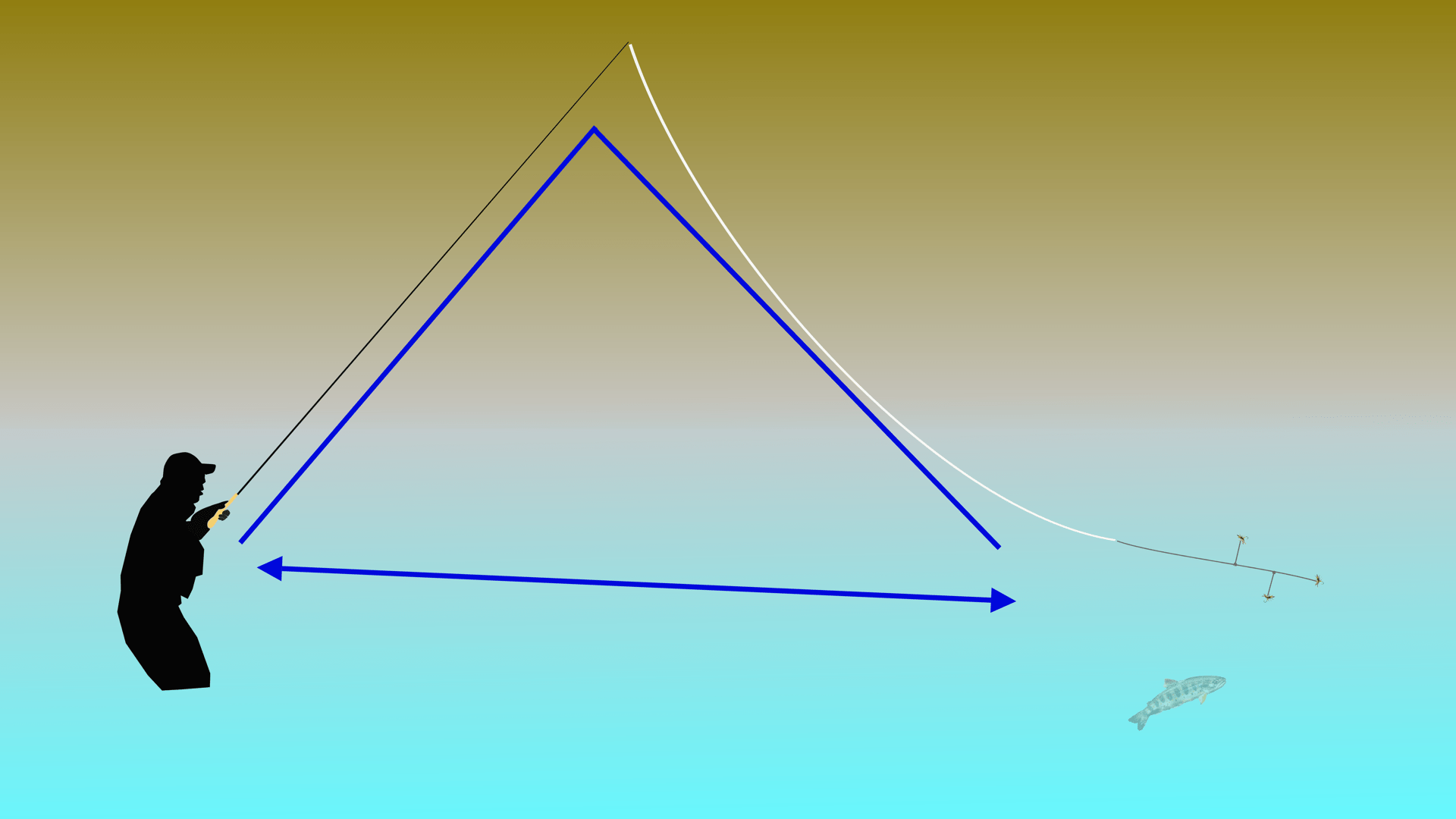
Casting Upstream and...Hey Look - it's the "Triangle of Awesome" from French nymphing again!
Instead, casting upstream – or up and across stream – could be seen as the bread and butter of the method. Using several, closely-spaced, flies on droppers means the angler needs to use casts that avoid tangles. The long rods used in valsesia amplify any stray movements of your casting hand – so you need to take care.
Constant Tension
There is a common skill that is used both when moving into a new position on-stream and also to help change the direction of your cast. Valsesiana anglers often use an overhead oval-shaped movement of their rod tip to keep their casting line in the air. This creates a constant tension in the line – so there is a much lower chance that any part of the line or tippet can cross over itself.
I need to find out if there is a specific name for this cast in Val de Sesia, however it has essentially the same mechanics as what Mel Krieger described as a "helicopter cast" that he uses as a teaching aid when changing the direction of the line and learning constant-tension casts such as Spey casting.
Having constant tension is also great for pre-loading the rod and then allowing you to change the direction of your final, forward, cast easily.
Don't be fooled into thinking this is the only casting technique though. A key part of determining how your fly will fish is controlled by your casting skills. For instance, snappy false casts will kick the water out of hackles and fly bodies and, with stiffer-hackled flies, allow you to make a presentation in the surface film of the stream.
Just be careful to avoid tangles when you do it!
Rods for pesca a mosca valsesiana
It probably doesn’t need pointing out – but valsesiana rods do not carry a reel. Their traditional construction from river reed (used whole and not split) and hazel has already been mentioned. The characteristics of those materials are what the modern, graphite, rods for this style of fishing seek to mimic.
Typically measuring around 4 to 4.5m (roughly 13 to 15 feet) in length, the rods have plenty of backbone in their middle and lower sections. That power is said to be similar to the feeling found in traditional Arundo cane rods – only graphite weighs a lot less.
Despite the move to graphite for rod-building, a traditional horsehair line is still many anglers’ favourite line. The opportunity to personally tune the taper, the casting performance and the feel are all special characteristics of horsehair. Usually the casting line will be approximately the same length as the rod – with your team of flies added onto the end of that.
Important People and Places
Monte Rosa is the mountain that feeds the rivers associated with valsesiana. Val de Sesia is at the foot of one of this mountain range’s three Italian faces (the north western face is in Switzerland). This is the homeland of pesca a mosca valsesiana.
Andrea Scalvini, as well as being an important figure in his own right, also maintains a website dedicated to preserving the methods and spirit of valsesiana. Andrea’s profiles of several important valsesian personalities are well worth reading. You can find them on the “Characters tab" on his blog menu.
Here I will briefly pick out two living legends from these elder statesmen: Renato Gonetto and Arturo Pugno.
Renato Gonetto
Renato, as I mentioned earlier, is the father of Manu who I know through fly fishing in England and Yorkshire. Renato even became world fly fishing champion with the Italian team who won the 6th world fly fishing championships in Belgium, 1986. He is a skilled rod-maker and recognised as an authority in pesca a mosca valsesiana.
It was Renato who made the multiple-sectioned Valsesia rods, with split-cane tips and whole river-cane main-sections, to Moretti’s design. This allowed people to carry valsesiana rods much more easily – particularly if they travelled to their fishing on two wheels!
Arturo Pugno
Very recently, Patagonia released a short film called “The Complete Fisherman” (Il pescatore complete). It was written and edited by Nick Waggoner, filmed and directed by Stefano Volcan and produced by Yvon Chouinard and Mauro Mazzo.
The subject of this film is the life spent in pursuit of fishing mastery by Arturo Pugno. It is beautifully made and allows Arturo to take centre-stage. Yvon Chouinard’s recognition of Arturo’s skill and insights is clear – but equally powerful is his statement that Arturo has the life Yvon aspires to.
Here is the film on Patagonia’s YouTube Channel:
Over to You
I hope you have enjoyed this quick tour of some of the elements of pesca a mosca valsesiana, drop a comment below and let me know your opinions on the content here.
Paul
More like this...
Catskill Fly Fishing, Wet Flies & Vincent Marinaro: In Conversation with John Shaner
Wet Fly Fishing: The Insider's Guide
Capturing Fishing on Film with Italian Film-maker Andrea Crobu

Thank you for sharing the techniques of Valsesiana and the beautiful Patagonia film.
You’re very welcome and thank you for the kind comments.
Paul
In some ways, this reminds me of the style of “wet fly” fishing that my grandfather taught me. We used 10 ft. fiberglass rods with silk lines and relatively short leaders (5 to 5 1/2 ft.). Two fly rig of soft hackle flies. Casts were typically short (lots of willows) up and across. Rod tip always held high so that the dropper skipped on the surface and the trailing fly just subsurface. If you missed a strike then you were either asleep or in need of a lunch break.
Thanks so much for sharing these fabulous stories and historical techniques. They are all relevant and applicable to those interested in learning more ways to satisfy our desire to catch fish
Brilliant stuff, I’m really enjoying this series of articles and thank you for sharing them
beautiful
Thank you Taine – that is very kind of you!
I have been extremely lucky to receive the flies and traditional tippet (as well as access to the “insider” tying demonstration filmed on Manu’s phone!).
Andrea Scalvini has been very generous in sharing information directly from the source.
Paul
Much the same as the loop rod style of fishing on the Clyde best discribed by webster in the angler and the loop rod, nine flies on the cast fished upstream on a horse hair casting line .
Webster’s book is great.
P
Truely an education, it is Great to see these wonderful fishing traditions being kept alive and well.
Good presentation thank you Paul
Alexander that is extremely kind of you to say and thank you. Everything from the silks, feathers, flies, line, rod (and especially the anglers) is just wonderful.
I would like to go there and study the techniques in more detail when I get the chance.
Paul
Oops sorry links on my previous post don’t work.
Here they are again
https://www.flickr.com/photos/dsriley1/50916208197/in/album-72157661507258408/
https://www.flickr.com/photos/dsriley1/50923089147/in/album-72157661507258408/
They look super appetising David – I’m sure they’re going to work for you.
Paul
Excellent Paul.
I have fished spider flies ‘on & off’ for many years. I recently started to
read up about the early flies especially about some tied with reverse hackles.
These days I only fish for coarse fish with a fixed line rod on a local canal. As there is little water movement I fish a spider tied with a very soft hackle. Unfortunately it is not as successful as I had hoped and started to wonder if a reversed hackle in the Sakasa Kebari style would work better.
I did a ‘reversed hackle’ internet search and came across the Valsesiana style of fly fishing, which is precisely what I was after, even though it is for fishing mountain stream/ fast water .However I cannot see why it will not work with the style of fixed line fly fishing I do and have tied up a few examples to try once I am able to fish again after lockdown ( I don’t drive so am reliant on buses)
I have tied up a few patterns. Here are photos of a couple.
https://www.flickr.com/photos/dsriley1/50923089147/in/album-https://www.flickr.com/photos/dsriley1/50916208197/in/album-72157661507258408/ 72157661507258408/
Great Stuff David, I’ll check out the links on your other reply.
Paul
Sir would dearly like to purchase furled leader inc. tippet material and flies as viewed.
Unfortunately don’t speak Italian and consequently can’t track purchases. Please advise
Geoff Mawson
Hi Geoff, as far as I know it isn’t actually possible to purchase those exact flies (since the tying of your own flies with the specific silks and feathers in your fingers is a core part of the fishing experience in this tradition).
However, you MAY be able to buy the authentic casting lines made by Andrea Scalvini who made the beautiful flies pictured in the article – which he very kindly sent me (and since they are tied to horse-hair tippet; these are basically precious museum pieces).
The kicker is, I don’t believe Andrea ships outside of the EU, so you might need to find a friendly recipient somewhere in Continental Europe who could receive and then forward-on your purchase. On the language front, the very best trick I know is to access Andrea’s site using Google Chrome browser and then (if it doesn’t happen automatically) click in the upper right section of the address bar to have the browser translate the pages into English.
Sometimes the option to translate will just pop up directly on your screen when you use Chrome (there may well be equivalent functions on other browsers too).
Here is where you might be able to buy lines: https://www.moscavalsesiana.it/it/shop
For the very keenest folks, Andrea offers courses in the fly tying, fishing/casting and line-making skills of Valsesiana style fishing, the lesson content may prove difficult unless you take an interpreter with you!
I hope it is obvious that Valsesiana fly fishing is an authentic and closely-guarded tradition (rather than a manufactured business opportunity). We work really hard to uncover these kinds of things (and to get to the source of authentic information as far as possible at all times). The upshot of that is, when we have to dig hard to get at the information, it often means there isn’t a readily available international supply chain for tackle and flies discussed.
I understand this will often be frustrating, and I hope there is still value in the lengths we go to in order to obtain and share snippets and photos/videos of the actual items when we are able to obtain some via our kind (and long-suffering) network of angling friends and supporters.
Paul
Hi there! Thank for the preservation of ancestral
Italian fishing tradition! Where could I find the making of the wooden fishing to be able to replicate the old rod that Arturo Pugno is using in the Patagonia film with Yvon Chouinard Mauro Mazzo?
Thanks for your time and concerns!:)
Hi Christian – I think that your best chance of getting authentic information on Arturo Pugno’s traditional rods are from Andrea Scalvini. He has a website and also a Facebook group based on Pesca alla Valsesiana.
Once we get beyond the COVID situation, I hope to travel to Monte Rosa and study with Andrea and, perhaps, Arturo.
Paul
Enjoying the content especially this particular thread, am wondering if there is a Horse hair substitute for hand making lines, I have tried some mono with a degree of success, but would be interested in other alternatives.
Hi Chris – I think that a manufacturer would have to set out with the specific intention of mimicking horse tail fibres to get better results than you can achieve with standard fishing nylon monofilament.
In some ways I suppose it would be a shame if anyone did come up with a perfect synthetic version; there’s a certain romance to using the natural fibre. However, I do understand the attraction of consistent and convenient materials.
Really glad that you’re enjoying the wet fly stuff Chris and thanks for contributing to the conversation.
Paul